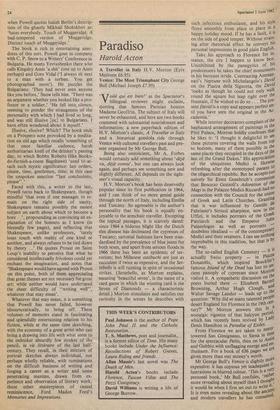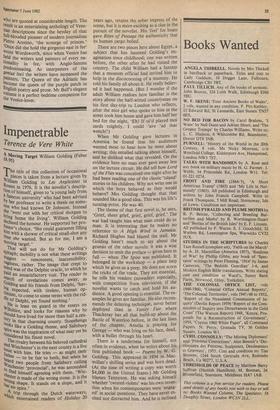Paradiso
Harold Acton
`I Todd qui est bien!' as the Spectator's V bilingual reviewer might exclaim, quoting that famous Parisian hostess Madame Geoffrin. The subject of Italy will never be exhausted, and here are two books crammed with substantial nourishment and information: a new paperback edition of H.V. Morton's classic, A Traveller in Italy and a historical gondola ride through Venice with cultured travellers past and pre- sent organised by Mr George Bull.
Being also omniscient, Mr A. Forbes would certainly add something about `déjà vu, dejd connu', but one can always look again, and perhaps see something new and slightly different. All depends on the sight- seer's visual capacity.
H.V. Morton's book has been deservedly popular since its first publication in 1964, and I can think of no more genial guide through the north of Italy, including Emilia and Tuscany. So agreeable is the author's personality that his book is equally en- joyable to the armchair traveller. Excepting the topical passages, it is scarcely dated: since 1964 a hideous blight like the Dutch elm disease has decimated the cypresses of Tuscany; sartorial fashions have been stan- dardised by the prevalence of blue jeans for both sexes, and apart from serious floods in 1966 there has been an epidemic of ter- rorism; but Milanese ossibuchi are just as succulent if twice as expensive, and the Set- tebello is still running in spite of occasional strikes. (Settebello, as Morton explains, meaning 'beautiful seven', is the name of a card game in which the winning card is the Seven of Diamonds — a characteristic detail.) Morton stimulates and satisfies our curiosity in the scenes he describes with
such infectious enthusiasm, and his style flows smoothly from place to place in a happy holiday mood. If he has a fault, it is on the side of good temper. Without strain- ing after rhetorical effect he conveys his personal impressions in good plain English.
Take his approach to Florence for in- stance, the city I happen to know hest. Uninhibited by the panegyrics of his predecessors he takes the chief monuments in his buoyant stride. Contrasting Anima-11r nati's Neptune with Michelangelo's David on the Piazza della Signoria, the David 'looks as though he could not only walk round the square but leap right over the fountain, if he wished to do so . . The pre- sent David is a copy and appears perfect un- til you have seen the original in the Ac- cademia.' While interior decorators complain of the haphazard arrangement of paintings in the Pitti Palace, Morton boldly confesses that he likes it: 'I thought it delightful to see these pictures covering the walls from top to bottom, many of them possibly in the same places they occupied in the days of the last of the Grand Dukes.' His appreciation of the ubiquitous Medici is likewise refreshing after the stereotyped paeans to the oligarchical republic. But he accepts too naively Sir Ernst Gombrich's contention that Benozzo Gozzoli's Adoration of the Magi in the Palazzo Medici-Riccardi had u° connection with the Council for the unt°11 of Greek and Latin Churches. Granting that it was influenced by Gentile da Fabriano's Strozzi altarpiece, now in the Uffizi, it includes portraits of the Greek Patriarch and the Emperor John Palaeologus as well as portraits doubtless idealised — of the contempora1 Medici and their retainers. I can see nothing improbable in this tradition, but that is by the way. The so-called English Cemetery — it is actually Swiss property — in Pia Donatello, which inspired Boecklin s famous Island of the Dead has lost its an- cient panoply of cypresses since Morton visited it. A sympathetic discussion on the poets buried there — Elizabeth Barrett Browning, Arthur Hugh Clough, an ,c1 Walter Savage Landor — leads up to the question: 'Why did so many talented neoPle desert England for Florence in the 19t11 e'en: tury?' Mr Morton answers this In a nostalgic vignette of that halcyon Perl°;.,' which has recently been revived by Lad" Denis Hamilton in Paradise of Exiles. From Florence we are taken to rnall. towered San Gimignano, to Siena in tar1e. for the spectacular Patio, then on to Assi'' and Gubbio with unflagging energy and en- thusiasm. For a book of 636 pages we are given more than our money's worth. Mr George Bull's Venice is slightly more expensive: it has copious yet inadequate il lustrations in blurred colour. 'This is a verY personal book,' Mr Bull confides, 'rather more revealing about myself than I thought, it would be when I first set out to writelt. It is even more revealing about the ancient and modern travellers he has consulted' who are quoted at considerable length. The result is an entertaining anthology of Vene- tian descriptions since the heyday of that full-blooded pioneer of modern journalism Pietro Aretino, 'the scourge of princes.' 'Once did she hold the gorgeous east in fee' Wrote Wordsworth, since when Venice has held the writers and painters of every na- tionality in fee, with Anglo-Saxons predominating. As interpreters of the genius loci the writers have surpassed the Painters. The Queen of the Adriatic has become the queen of the purple patch in English poetry and prose. Mr Bull's elegant volume is a perfect bedtime companion for the Venice-lover.







































 Previous page
Previous page